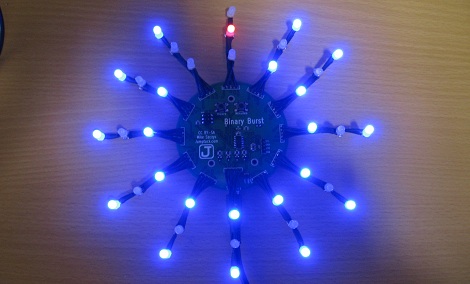
Hackaday’s very own [Mike Szczys] just shared an awesome binary clock he’s been working on. Unlike a normal binary clock that is only readable by self-admitted geeks and nerds, [Mike]’s clock is nearly comprehensible by the general population.
There are 12 lines of three LEDs around the face of [Mike]’s clock. These LEDs represent the time in minutes in binary – the inner LED is 1, the middle LED is 2, and the outer LED is 4. Adding up each of the LEDs around the clock face gives the number of minutes passed since the top of the hour.
To display the hour, [Mike] used a red/blue bi-color LED in the center of each line of LEDs. For example, at 1:03 the one ‘o clock hand will have a blue LED in the first position and a purple LED in the second position. A minute later at 1:04, this changes to blue, red, blue.
If that is a little confusing, there’s a wonderful video demonstrating the pattern of LEDs throughout the hour.
For such an interesting clock, the build is fairly simple – just an ATtiny44 with an STP16CP05 LED driver. Time is kept with a battery-backed MCP7940 real-time clock, and power is provided by a simple USB port.
[Mike] had enough boards manufactured for several dozen clocks, but only had enough parts (and patience) to solder up four clocks. You can check out the time-lapse of him going to town with a soldering iron on one of these boards after the break. As with all good builds, the code and schematics are provided on GitHub if you’d like to make your own.
[youtube=http://www.youtube.com/watch?v=ItUmJYx2YAc&w=470]
[youtube=http://www.youtube.com/watch?v=v9x7FkXW6Mo&w=470]
















Thanks for that video, Mike. Now we know how to pronounce your last name :)
So if the center LED is blue, that’s a 2, if it’s red then it’s an hour, and if it’s purple, then it’s both?
You mean you weren’t able to sound out my name by the way it’s spelled? ;-)
You’re right about the colors. I chose to use the middle LED as the Red/Blue bit because this way it will only be purple once per hour. It’s just a coincidence that it worked out this way for the video.
Haha. I think I was pronouncing it something like “Sizzicks” in my internal monologue. Nice clock and all, but I really came to say you have a surprisingly deep voice for an electronics nerd.
Interesting concept. As someone who uses a binary clock daily, I actually have more difficulty reading this one!
As for the last name, I believe it’s pronounce something closer to Shh-tihsh if I’m correct (Grandfather is Czech).
*Facepalm* OK, I totally didn’t watch the video only to find out you say your own name in it! Anyway, back to my corner…
Blue and purple? This is not a project for the colourblind…
Less than one hundredth of one percent of humans experience Tritanomaly/Tritanopia (blue-color blindness), as opposed to 1% of males having Protanomaly/Protonopia (green-color blindness) or 6% of males having Deuteranomaly/Deuteropia (red-color blindness). Furthermore, there are frequently crosses between green and red blindness, where blue-yellow blindness is a different spectrum entirely and usually occurs by itself or as Achromatopsia(grayscale vision).
As red/green is the most common bicolor LED, I’d say he did the world a favor making it red/blue bi-color. It is actually more color-blind-friendly than if he had used any other known bi-color LEDs such as green/red, green/amber, or red/amber.
you can cut the trace to the button, (scratch cut) scrape back the solder mask a bit, and put an smt resistor in the trace. (to keep it from shorting when operating the led)
Yeah, originally I wanted this LED for feedback while getting the multiplex display up and running. Later I thought it could be used for seconds or something else. But really it’s not needed so I’ll just leave it unpopulated.
I know its not as dramatic, but whats this, HaD staff without a toaster oven for smt?
Since I’ve placed SMD components on both sides of the PCB this isn’t a good candidate for reflow. If I were to design a second version I’d probably work on getting everything on the same side of the board.
Nice idea, but did you have to make it look like a tarantula?
a tarantula with 12 legs? Thats quite an imagination there